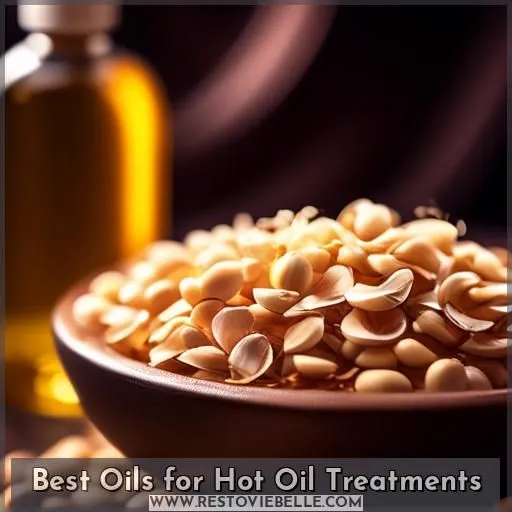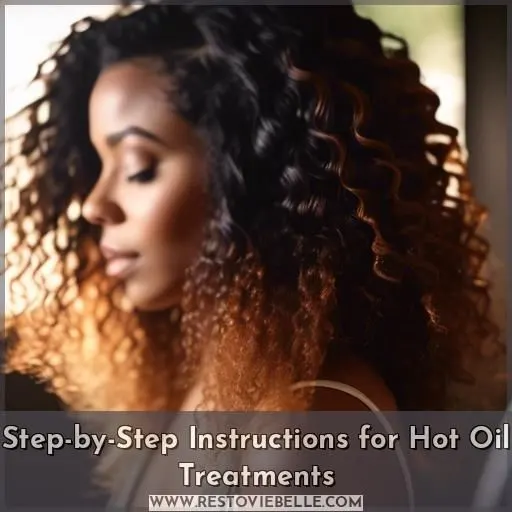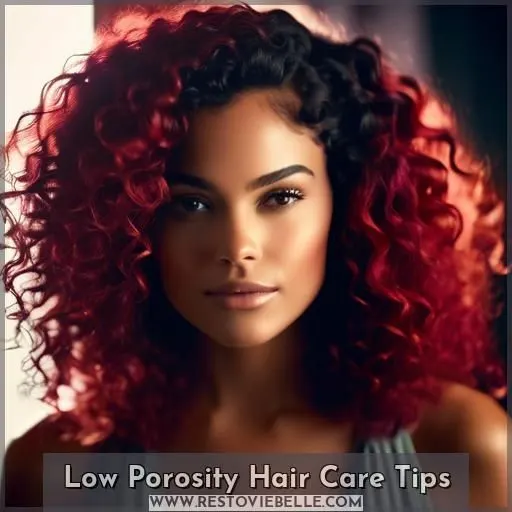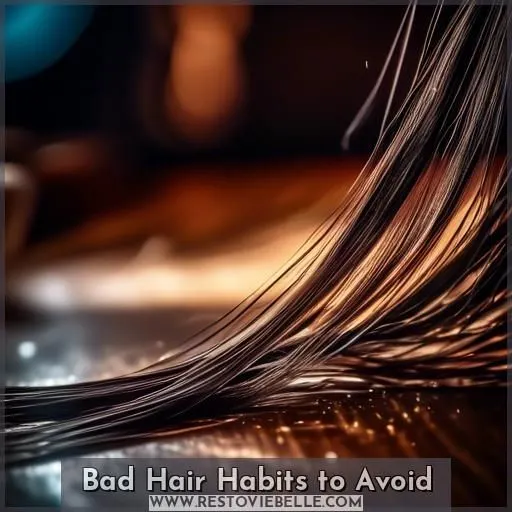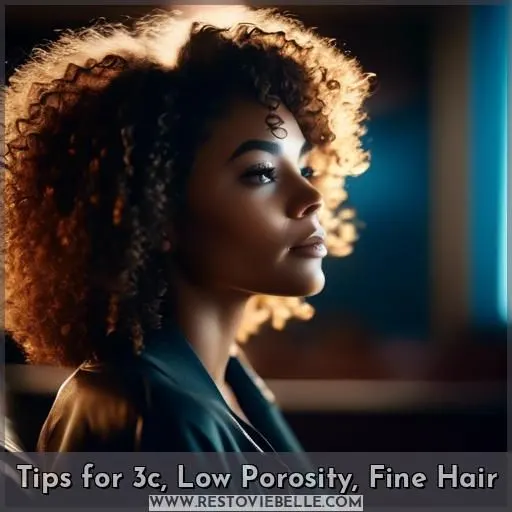This site is supported by our readers. We may earn a commission, at no cost to you, if you purchase through links.
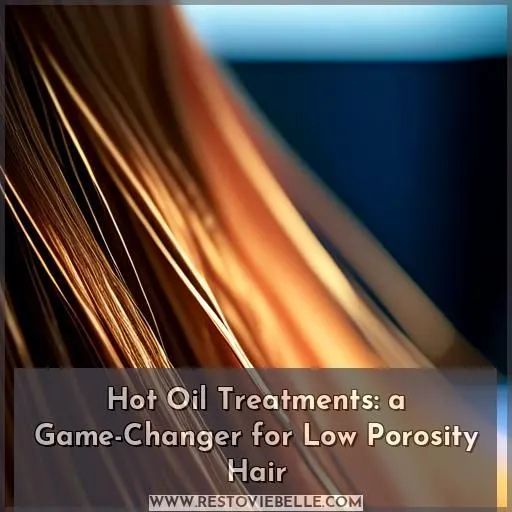
Yes, hot oil treatments can be highly beneficial for low porosity hair. The oils slowly penetrate the tightly sealed cuticles, deeply nourishing and hydrating strands. Jojoba, rosehip, and coconut oils are particularly effective, as they’re easily absorbed and provide intense moisture.
Be sure to warm the oil before application, cover your hair, and leave it on for 30-60 minutes for maximum impact. Regular hot oil treatments can improve manageability, reduce frizz, and strengthen low porosity hair.
To truly transform your tresses, keep reading to discover a customized hot oil routine designed to meet your specific hair needs.
Table Of Contents
- Key Takeaways
- Are Hot Oil Treatments Good for Low Porosity Hair?
- Benefits of Hot Oil Treatments for Low Porosity Hair
- Best Oils for Hot Oil Treatments
- Step-by-Step Instructions for Hot Oil Treatments
- Frequency and Duration of Hot Oil Treatments
- Considerations for Hot Oil Treatments
- Low Porosity Hair Care Tips
- Bad Hair Habits to Avoid
- Regimen and Product Recommendations
- Tips for 3c, Low Porosity, Fine Hair
- Hot Oil Treatment Alternatives and Combinations
- Frequently Asked Questions (FAQs)
- Conclusion
Key Takeaways
- Hot oil treatments are beneficial for low porosity hair, as they penetrate the tightly sealed cuticles and provide deep nourishment and hydration.
- Jojoba, rosehip, and coconut oils are particularly effective for low porosity hair, as they are easily absorbed and provide intense moisture.
- Regular hot oil treatments can improve manageability, reduce frizz, and strengthen low porosity hair.
- To get the best results from hot oil treatments, choose the right oil, warm it before application, apply it to damp hair, and leave it on for 30-60 minutes.
Are Hot Oil Treatments Good for Low Porosity Hair?
Yes, hot oil treatments are beneficial for low porosity hair as they help in sealing moisture, reducing damage, and adding shine without weighing the hair down. These treatments utilize lightweight oils like argan, coconut, and jojoba, which are ideal for nourishing and strengthening low porosity hair.
Benefits of Hot Oil Treatments for Low Porosity Hair
Hot oil treatments are a game-changer for low porosity hair, offering numerous benefits that can enhance your hair’s health and appearance. These treatments help seal cuticles, enhancing moisture retention and preventing frizz.
They also promote growth by nourishing strands and strengthening them from the inside out. Coconut oil, a popular choice for hot oil treatments, is rich in antioxidants and fatty acids that can improve hair moisture.
By incorporating hot oil treatments into your hair care routine, you’ll notice a significant difference in your hair’s overall health and shine.
Best Oils for Hot Oil Treatments
Regarding hot oil treatments for low porosity hair, the selection of oil is paramount. Opt for oils characterized by their lightness, ease of absorption, and abundance of nutrients and vitamins. Here are three highly recommended oils for hot oil treatments for low porosity hair:
-
Jojoba Oil: This oil is widely acclaimed as the benchmark for low-porosity hair. Its similarity to the scalp’s natural sebum facilitates its absorption. Jojoba oil is non-greasy, weightless, and an ideal conditioner that won’t burden your hair. It’s brimming with essential nutrients such as vitamins B, C, E, copper, and zinc, contributing to hair hydration, scalp soothing, hair growth stimulation, and frizz control.
-
Rosehip Oil: For centuries, this oil has been a mainstay for low-porosity hair. It provides a substantial amount of fatty acids, antioxidants, polyphenols, and vitamins C, A, and E. Polyphenols and vitamin E possess anti-inflammatory properties that alleviate discomfort and scalp irritation. Rosehip oil also contains phytonutrients that shield cells from free radical damage, promoting long-term hair health.
-
Coconut Oil: This oil is a favored choice for hot oil treatments because of its ability to deeply penetrate the hair shaft, addressing dryness and frizz. Its high concentration of saturated fatty acids aids in smoothing the cuticle and imparting shine to the hair. Additionally, it helps to moisturize the hair, a crucial consideration when using hot oil on your hair.
Step-by-Step Instructions for Hot Oil Treatments
Hot oil treatments are a popular hair care routine for those with low porosity hair. They can provide a range of benefits, including deep hydration, improved shine, and enhanced hair texture. Here’s a step-by-step guide on how to do a hot oil treatment at home:
- Choose the right oil: Select an oil that suits your hair type and desired benefits. For low porosity hair, consider using sealing oils like castor or grapeseed oil, or moisturizing oils like coconut or olive oil.
- Warm the oil: Heat the oil in a double boiler or microwave until it’s warm but not hot. Test the temperature on your wrist before applying it to your hair.
- Apply the oil: Divide your hair into sections and apply the warm oil generously to your scalp and hair lengths. Massage gently to increase circulation.
- Cover your hair: Cover your hair with a shower cap or a warm towel to help retain heat for better oil absorption.
- Leave it on: Allow the oil treatment to sit on your skin for at least 30 minutes to an hour, or overnight for a more intensive treatment.
- Rinse and shampoo: Wash your hair thoroughly with shampoo to remove the oil.
- Condition: Follow up with conditioner on the lengths and ends of your hair if necessary.
- Style your hair: Let your hair air dry or style it as usual, enjoying the improved softness, shine, and manageability.
Remember to do a patch test before using any new oil to make sure you’re not allergic to it. Hot oil treatments can be done once or every other week, depending on your preference. It’s also essential to avoid applying the oil to dry or dirty hair, as it can cause build-up.
Frequency and Duration of Hot Oil Treatments
Now that you’ve got the hang of warming up and applying those nourishing oils, let’s talk turkey about how often you should indulge in this hair care ritual. Here’s the lowdown:
- Oil Selection: Pick your potion wisely; not all oils are created equal for low porosity hair.
- Treatment Frequency: Aim for a hot oil treatment every two weeks—it’s the sweet spot for keeping your locks luscious without overdoing it.
- Duration: Keep it short and sweet, 20-30 minutes under the cap should do the trick to prevent any damage and keep your hair regimen on point.
Considerations for Hot Oil Treatments
Regarding hot oil treatments, comprehending the hair’s porosity level is essential. Low porosity hair types may find benefit from hot oil treatments, but the frequency and oil choice should be customized to your individual requirements.
Assessing Hair Porosity
To determine your hair porosity, perform a porosity test. Place a strand of hair in water. If it sinks, you have low porosity hair. If it floats, you have high porosity hair.
Understand your hair texture and moisture needs. Low porosity hair may require more oil treatments, while high porosity hair may need more moisture.
Hot oil treatments can help seal cuticles and protect strands, but the frequency and duration depend on hair porosity and treatment goals.
Frequency of Treatments
Regarding hot oil treatments for your low porosity hair, consider frequency as your hair care cadence. Excessive use might overburden your tresses; insufficient use denies them growth and luster. Strive for an equilibrium—consistent sessions that harmonize with your hair’s needs, without overstepping its boundaries.
Oil Selection Criteria
When selecting oils for hot oil treatments, consider the chemistry, penetration, heat retention, viscosity, and fragrance of the oil. For low porosity hair, opt for oils that penetrate deeply and have good heat retention, such as castor and grapeseed oils.
If you prefer a moisturizing treatment, choose oils like coconut and olive. For quick absorption, consider oils like jojoba and almond.
Always patch test before use to avoid reactions.
Low Porosity Hair Care Tips
Low porosity hair requires special care to maintain its health and prevent damage. Here are some tips for pre-poo treatments, detangling techniques, and moisturizing methods to enhance product absorption and promote healthy hair growth:
- Pre-poo treatments: Apply hot oil treatments before shampooing to seal in moisture and protect hair from damage.
- Detangling techniques: Use a wide-tooth comb or your fingers to gently detangle hair, starting from the ends and working your way up to the roots. Avoid pulling or tugging at knots, as this can cause breakage.
- Moisturizing methods: Apply products to damp hair to help them penetrate the hair shaft more effectively. Use lightweight oils like jojoba or almond for quick absorption, and heavier oils like argan or coconut for deep hydration.
Additionally, incorporating rhassoul clay into your hair care routine can provide numerous benefits, such as cleansing, conditioning, and promoting hair growth. Try using a rhassoul quick wash recipe for an easy and effective hair treatment.
Bad Hair Habits to Avoid
Avoiding detrimental hair habits is paramount for preserving the health of low porosity hair. Excessive moisturizing can culminate in dandruff, oiliness, and hair loss, whereas insufficient moisturizing can lead to dry, fragile, and coarse hair.
Establishing unattainable hair objectives can engender disappointment and anxiety. Neglecting to investigate products and techniques can result in ineffective or injurious hair care.
Impatience with hair growth can foster excessive manipulation and damage. To obviate product accumulation, cleanse hair weekly and employ the OLC method.
Diminish breakage by shunning heavy products and utilizing heat to facilitate the opening of hair follicles. Formulate a daily moisturizing routine and select oils tailored to hair requirements.
Regimen and Product Recommendations
Step into a world where your hair is nourished, moisturized, and thriving with our expert regimen and product recommendations. Low porosity hair requires a gentle touch, so avoid over-moisturizing and under-moisturizing.
Opt for weekly deep conditioning and moisturize without buildup. Select oils based on absorption techniques and heat-hydration. Grapeseed oil is a great choice for sealing cuticles, while castor oil adds shine.
Scalp massage is key, so consider hot oil treatments for an added boost. The right routine can transform your hair journey.
Tips for 3c, Low Porosity, Fine Hair
- Detangling Techniques: Start detangling your hair when it’s wet and coated with a moisturizing conditioner. Use a wide-toothed comb or a detangling brush, starting at the ends and working your way up to the roots. Always detangle in sections, using a few sectioning clips to secure your hair into smaller sections.
- Pineapple Hairstyle: After washing your hair, try the pineapple hairstyle to help your curls dry without tangling. Gather your hair at the crown of your head and secure it with a scrunchie or a silk scarf. This technique helps to maintain the natural curl pattern and reduce tangles.
- OLC Method: Follow the Oils, Liquids, Creams (OLC) method for moisturizing your hair. Start with a leave-in conditioner, then apply a hair oil to seal in moisture, and finally use a curl defining cream or mousse for styling.
- Heat Enhancement: Use heat (e.g., steam caps, plastic caps, microwaved products) to enhance product absorption and wash your hair with hotter water to open hair follicles and hydrate your hair.
Hot Oil Treatment Alternatives and Combinations
Hot oil treatments offer a range of benefits for low porosity hair, from sealing cuticles to promoting growth. But, if you’re looking for alternatives or combinations, consider these options:
- Cupuaca Butter: This butter is rich in fatty acids and vitamins, making it a great alternative to traditional oils. It can be used as a pre-poo treatment for added benefits.
- Overnight Treatments: For deeper penetration, try an overnight treatment. Combine castor oil with coconut oil for a powerful moisturizing blend.
- Recipes: Mixing oils is a fun way to create personalized treatments. Try a blend of jojoba oil, almond oil, and castor oil for a lightweight, nourishing mix.
- Variations: Don’t limit yourself to traditional hot oil treatments. Experiment with oil sprays, leave-in treatments, or even oil-infused hair masks.
Frequently Asked Questions (FAQs)
What is the ideal temperature for a hot oil treatment?
The ideal temperature for a hot oil treatment is warm, not scalding hot. You’ll want the oil heated just enough to melt and easily spread through your hair without burning your scalp. Start with a gentle, comfortable warmth.
How often should I do a hot oil treatment for low porosity hair?
For low porosity hair, you’ll get the most benefit from a hot oil treatment once a month. Any more and you risk over-oiling your strands. Keep it simple and let the oil work its magic.
Can I use a hot oil treatment on wet hair?
You can absolutely use a hot oil treatment on wet hair! The warm oil will absorb better and penetrate strands more deeply when applied to damp tresses. Just be sure to thoroughly rinse after the treatment.
How long should I leave the oil in my hair for a hot oil treatment?
You’d think letting that hot oil soak in forever would work wonders, but 20-30 minutes is all your hair needs to soak up the goodness. Any longer and you’re just giving it a toasty spa day!
Can I combine a hot oil treatment with other hair care methods?
Hot oil treatments blend wonderfully with other hair care methods. Just be mindful of porosity and tweak your routine to optimize absorption and lock in moisture. Your locks will thank you!
Conclusion
Discover the key to your hair’s metamorphosis with hot oil treatments. As the gateway to unleashing the potential of your low porosity hair, these restorative elixirs can revitalize your tresses.
Harness the potency of oils such as jojoba, rosehip, and coconut, and embark on your hair’s extraordinary odyssey toward improved manageability, diminished frizz, and fortified strands.
Are hot oil treatments beneficial for low porosity hair? Indisputably – they’re a transformative force that will leave your hair feeling more wholesome, content, and radiant than ever before.

